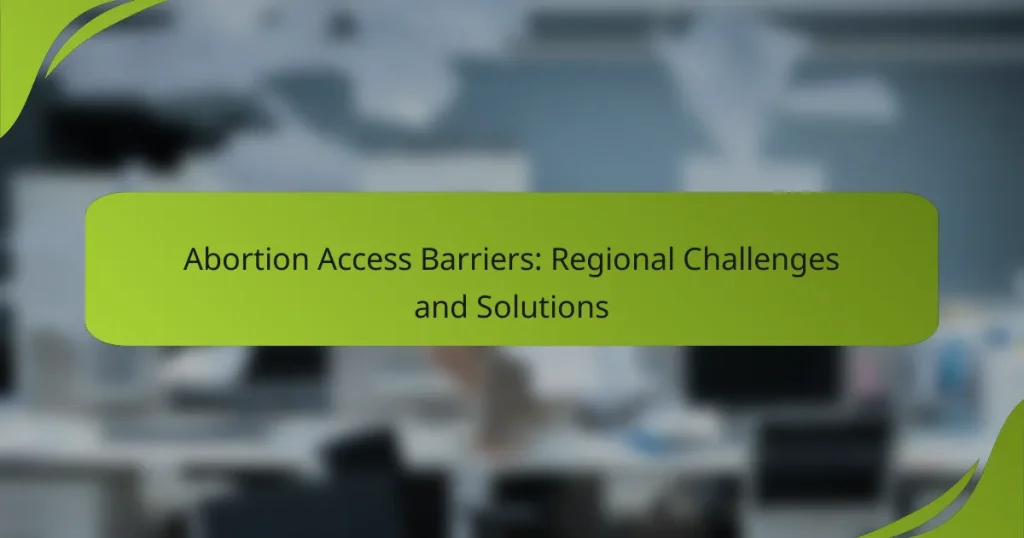Access to abortion services in the United States is hindered by a range of barriers, including legal restrictions, financial challenges, and geographic disparities. These obstacles can severely limit individuals’ ability to obtain safe and timely care, with state laws further complicating the situation through varying regulations. Addressing these issues necessitates a comprehensive strategy that encompasses policy reforms, enhanced funding for clinics, and the integration of telehealth services to improve accessibility.
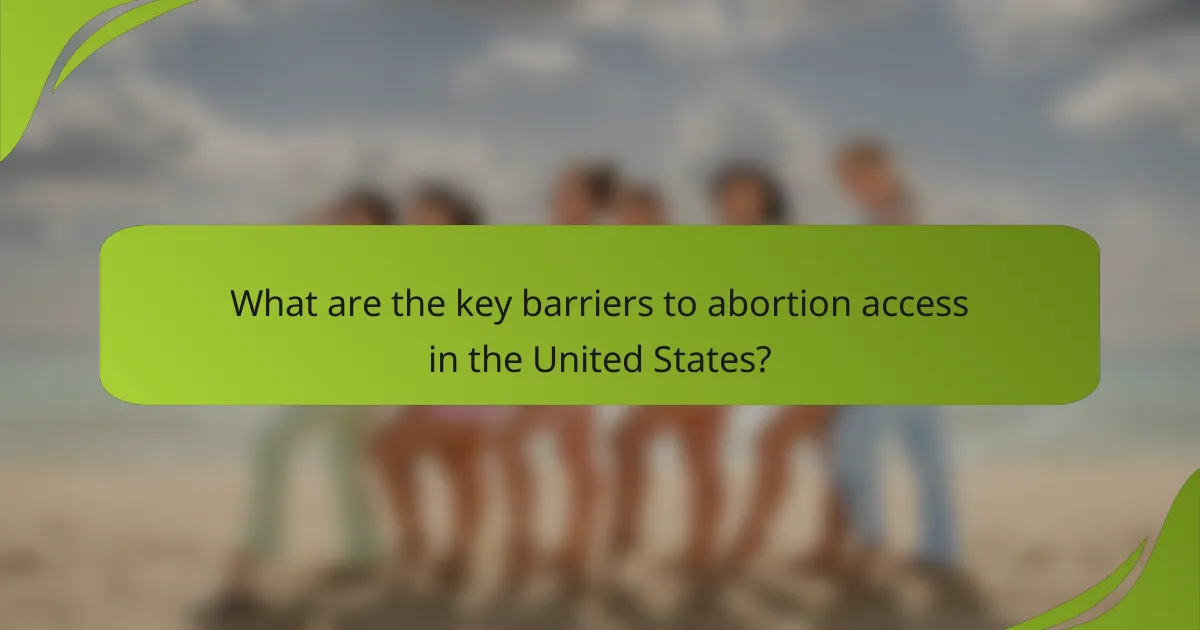
What are the key barriers to abortion access in the United States?
Key barriers to abortion access in the United States include legal restrictions, financial obstacles, geographic disparities, healthcare provider shortages, and stigmatization and misinformation. These challenges can significantly impact a person’s ability to obtain timely and safe abortion services.
Legal restrictions
Legal restrictions on abortion vary widely across the United States, with some states imposing strict regulations that can limit access. These may include mandatory waiting periods, parental consent laws for minors, and gestational limits that restrict when an abortion can be performed.
In some regions, laws may require specific counseling sessions or ultrasound procedures before an abortion can be obtained, adding additional steps to the process. Understanding the legal landscape in your state is crucial for navigating these barriers effectively.
Financial obstacles
Financial obstacles are significant barriers to abortion access, as the cost of the procedure can vary widely. Many insurance plans do not cover abortion services, and out-of-pocket expenses can range from a few hundred to over a thousand dollars, depending on the location and type of service.
Low-income individuals may face additional challenges, as they often lack the resources to cover these costs. Some organizations provide financial assistance or sliding scale fees, which can help alleviate these burdens.
Geographic disparities
Geographic disparities play a crucial role in abortion access, with rural areas often having fewer clinics than urban centers. In some states, individuals may need to travel long distances to reach the nearest provider, which can add time and cost to the process.
Transportation challenges can further complicate access, especially for those without reliable means of travel. Identifying local resources and support networks can help mitigate these geographic barriers.
Healthcare provider shortages
Healthcare provider shortages can significantly limit access to abortion services, particularly in areas where few practitioners are willing or able to provide care. This shortage can be attributed to various factors, including restrictive laws and the stigma surrounding abortion.
As a result, individuals may experience longer wait times for appointments or may be unable to find a provider altogether. Advocating for increased training and support for healthcare professionals can help address this issue.
Stigmatization and misinformation
Stigmatization and misinformation surrounding abortion can create additional barriers to access. Many individuals may feel ashamed or fearful of seeking services due to societal attitudes or misconceptions about the procedure.
Access to accurate information is essential for making informed decisions. Educational initiatives and supportive community resources can help combat stigma and provide clear, factual information about abortion services and options.

How do state laws impact abortion access?
State laws significantly influence abortion access by establishing regulations that can either facilitate or hinder the process. These laws vary widely across the United States, affecting gestational limits, waiting periods, and parental consent requirements, which can create barriers for individuals seeking abortions.
Variability in gestational limits
Gestational limits refer to the maximum number of weeks into a pregnancy that an abortion can legally be performed. In the U.S., these limits can range from as early as six weeks in some states to up to 24 weeks in others. This variability means that individuals in states with stricter limits may have less time to make decisions and access services.
For example, states like Texas impose a six-week limit, which can be challenging for those who may not realize they are pregnant until after this period. Understanding local laws is crucial for individuals to navigate their options effectively.
Mandatory waiting periods
Mandatory waiting periods require individuals to wait a specified amount of time between an initial consultation and the abortion procedure. These periods can range from 24 to 72 hours, depending on the state. Such requirements can create logistical challenges, especially for those who may need to travel long distances to access care.
For instance, if a state mandates a 48-hour waiting period, individuals may need to schedule additional time off work or arrange for childcare, which can complicate the process. Being aware of these waiting periods can help individuals plan accordingly.
Parental consent requirements
Parental consent requirements mandate that minors obtain permission from a parent or guardian before accessing an abortion. These laws vary by state, with some requiring consent from both parents, while others allow for judicial bypass options. This can pose significant barriers for young individuals seeking confidential care.
In states with strict parental consent laws, minors may face delays or may be unable to obtain the necessary permissions, impacting their ability to access timely care. Understanding these requirements is essential for minors and their families to navigate the legal landscape effectively.
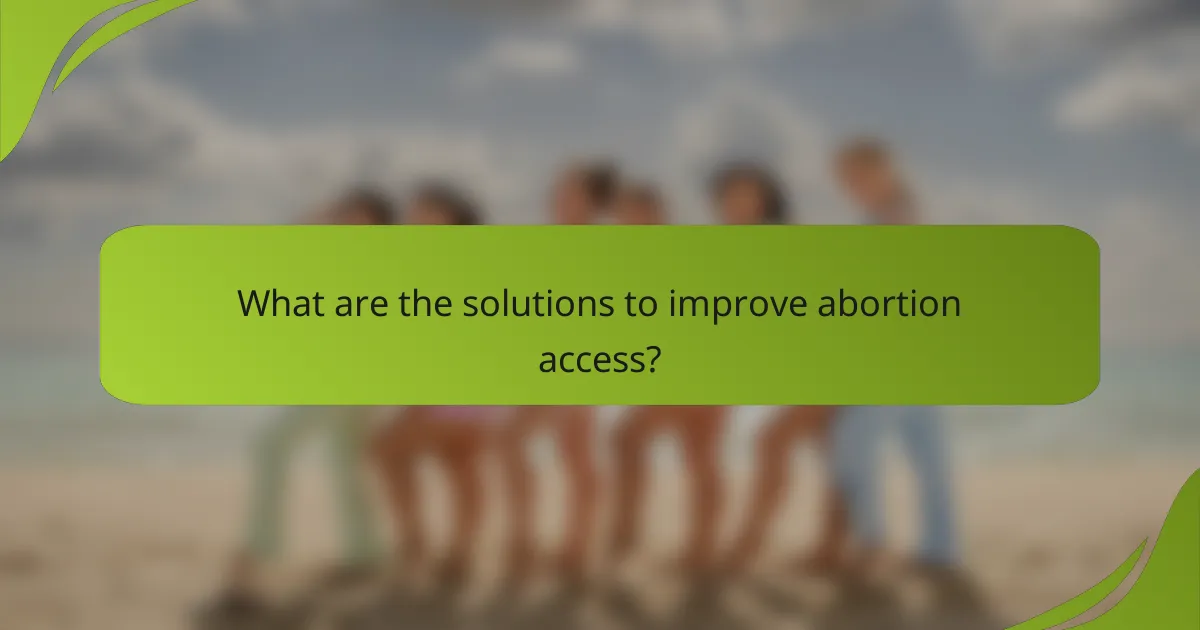
What are the solutions to improve abortion access?
Improving abortion access requires a multifaceted approach that includes policy reforms, increased funding for clinics, and the expansion of telehealth services. These solutions aim to reduce barriers and ensure that individuals can obtain the care they need in a timely manner.
Policy reforms
Policy reforms are essential for enhancing abortion access by eliminating restrictive laws and regulations. This may involve advocating for the repeal of waiting periods, mandatory counseling, and parental consent requirements that can delay access for minors.
Additionally, implementing protections for healthcare providers can encourage more practitioners to offer abortion services. States can consider adopting laws that safeguard against legal repercussions for providers who perform abortions in accordance with established medical guidelines.
Increased funding for clinics
Increased funding for clinics is crucial to ensure they can operate effectively and provide comprehensive care. This funding can be sourced from government grants, private donations, and nonprofit organizations dedicated to reproductive health.
Financial support can help clinics expand their services, hire additional staff, and improve facilities. For instance, clinics that receive adequate funding can offer a wider range of reproductive health services, making them more accessible to underserved populations.
Telehealth services
Telehealth services can significantly improve access to abortion care, especially in rural or underserved areas. By allowing patients to consult with healthcare providers remotely, telehealth can reduce travel time and associated costs.
Patients can receive counseling, prescriptions, and follow-up care through secure online platforms. However, it is important to ensure that telehealth services comply with local regulations and that patients are informed about the legal aspects of obtaining abortion care in their region.
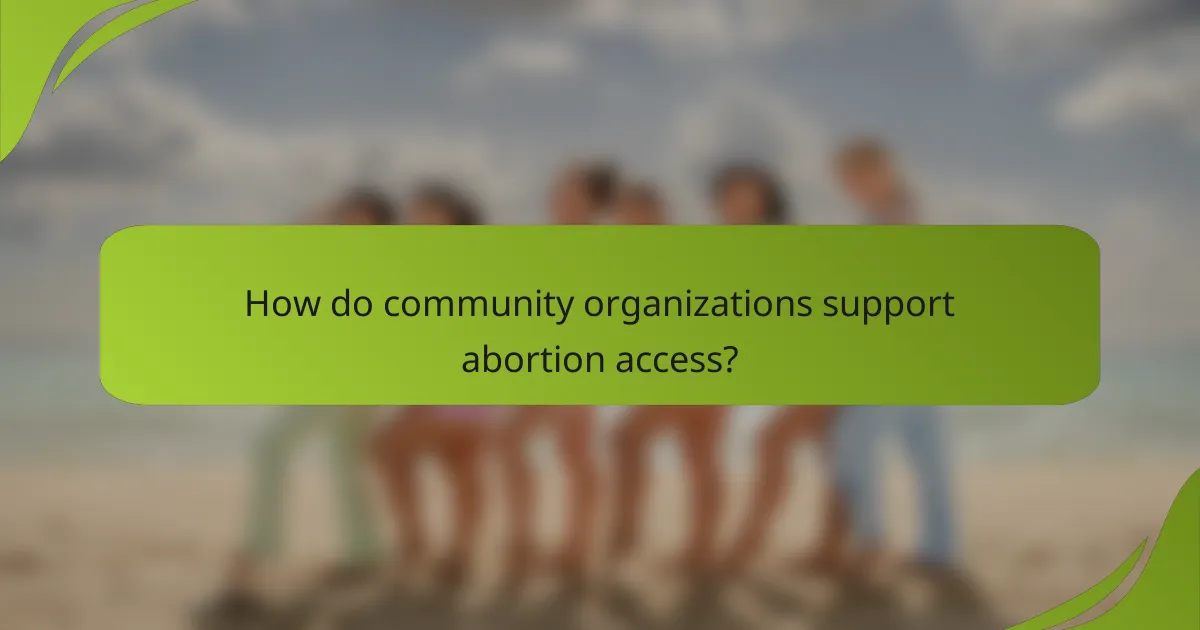
How do community organizations support abortion access?
Community organizations play a crucial role in enhancing abortion access by addressing various barriers that individuals face. They provide essential services such as financial assistance, transportation, and educational outreach to ensure that those in need can obtain the care they require.
Providing financial assistance
Financial constraints often prevent individuals from accessing abortion services. Community organizations can help by offering grants or low-interest loans to cover costs associated with the procedure, including clinic fees and related medical expenses.
Some organizations may also assist with costs for necessary follow-up care or medications. Individuals should research local resources to identify available financial support options, which can significantly alleviate the burden of expenses.
Offering transportation services
Transportation barriers can hinder access to abortion services, especially in rural areas where clinics may be far away. Community organizations often provide transportation assistance, such as rideshare programs or partnerships with local transit services, to help individuals reach clinics safely and on time.
It’s important for organizations to coordinate these services effectively, ensuring that individuals have reliable options for both arriving at and returning from their appointments. Individuals should inquire about these services when seeking assistance to ensure they can access the care they need.
Education and outreach programs
Education and outreach programs are vital for raising awareness about abortion access and available resources. Community organizations often conduct workshops, distribute informational materials, and engage in social media campaigns to inform individuals about their rights and options regarding abortion.
These programs can help dispel myths and provide accurate information about the abortion process, potential risks, and aftercare. Individuals are encouraged to participate in local events or access online resources to stay informed about their reproductive health rights and available support systems.
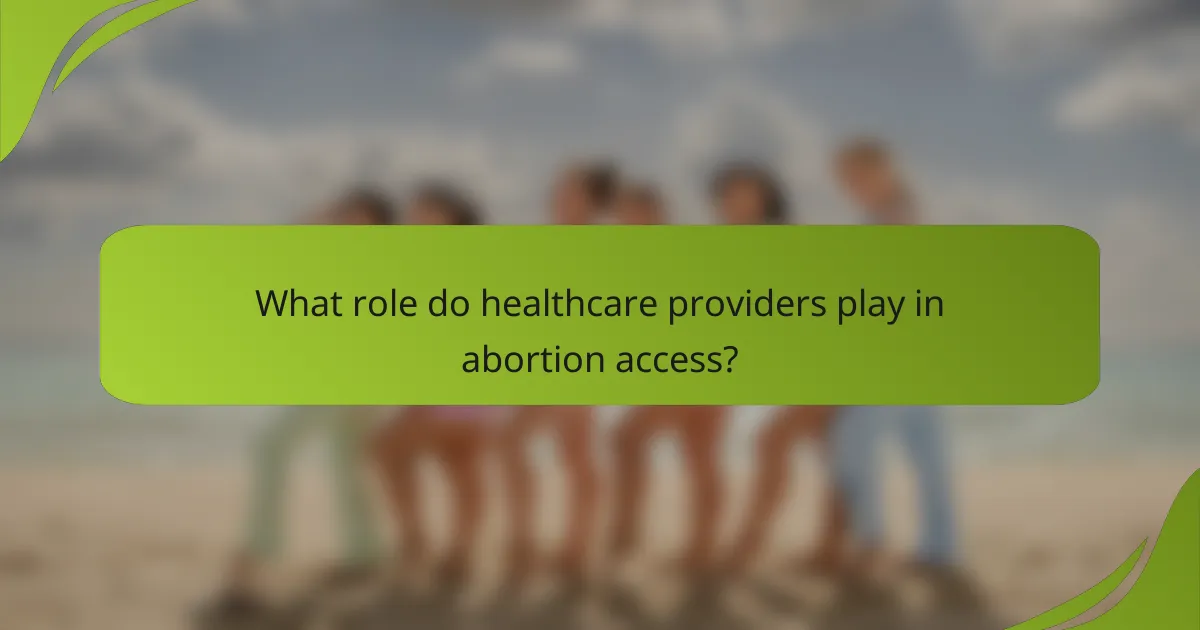
What role do healthcare providers play in abortion access?
Healthcare providers are crucial in ensuring access to abortion services, as they offer medical expertise, counseling, and support throughout the process. Their role encompasses not only performing procedures but also educating patients about their options and rights.
Training and education initiatives
Training and education initiatives for healthcare providers are essential to improve abortion access. These programs equip providers with the necessary skills and knowledge to perform procedures safely and effectively, while also addressing the emotional and psychological aspects of patient care.
For example, workshops and online courses can cover topics such as the latest medical guidelines, patient communication strategies, and legal considerations. Continuous education helps providers stay informed about evolving regulations and best practices.
Advocacy for patient rights
Healthcare providers play a vital role in advocating for patient rights regarding abortion access. They can help ensure that patients receive accurate information about their options and support them in navigating legal and healthcare systems.
Providers can also engage in policy advocacy, working with local and national organizations to promote laws that protect and expand access to abortion services. This advocacy can lead to improved healthcare policies that prioritize patient autonomy and informed consent.
Collaboration with local organizations
Collaboration with local organizations enhances the ability of healthcare providers to offer comprehensive abortion services. By partnering with community groups, providers can better understand the specific needs and barriers faced by patients in their region.
These partnerships can facilitate resource sharing, such as providing transportation for patients or offering financial assistance for those who cannot afford the procedure. Working together, healthcare providers and local organizations can create a more supportive environment for individuals seeking abortion services.
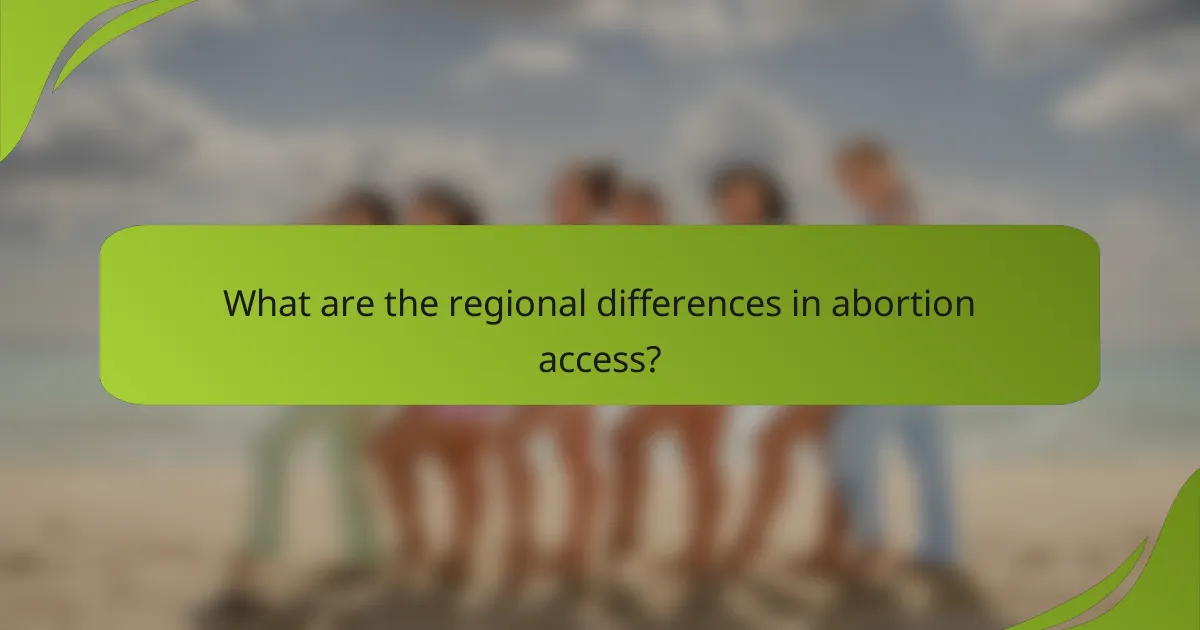
What are the regional differences in abortion access?
Abortion access varies significantly across regions due to differing laws, healthcare infrastructure, and cultural attitudes. These disparities can impact the availability of services, the cost of procedures, and the overall experience for individuals seeking abortions.
Legal Restrictions
Legal restrictions on abortion can differ widely between regions. In some areas, laws may allow abortions up to a certain number of weeks, while others may impose strict bans or require extensive waiting periods. For instance, many states in the U.S. have enacted laws that limit access, while countries like Canada have no legal restrictions on abortion at any stage of pregnancy.
Understanding the specific legal framework in your region is crucial. Individuals should consult local resources or legal experts to navigate these laws effectively and ensure compliance with any requirements that may apply.
Healthcare Infrastructure
The availability of healthcare facilities that provide abortion services can greatly influence access. In urban areas, individuals may find multiple clinics offering a range of reproductive health services, while rural regions often have limited options. This can lead to increased travel times and costs for those seeking care.
Individuals in areas with fewer facilities should explore telehealth options, which may provide consultations and prescriptions remotely. Additionally, connecting with local advocacy groups can help identify available resources and support networks.
Cultural Attitudes
Cultural attitudes towards abortion can create significant barriers to access. In regions where abortion is stigmatized, individuals may face social pressure or discrimination when seeking care. This can deter people from accessing necessary services or discussing their options openly.
Engaging with supportive communities or organizations that promote reproductive rights can help individuals feel more empowered. It is also beneficial to seek out educational resources that provide accurate information about abortion and reproductive health to counteract stigma.
